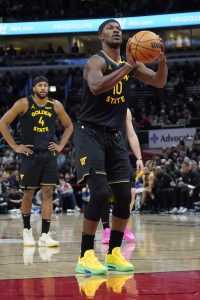As they scoured the market for another star last summer, the Warriors attempted to engineer an opt-in-and-trade scenario to acquire Paul George from the Clippers before the veteran forward instead declined his player option in order to sign a maximum-salary free agent contract with the Sixers.
Golden State subsequently shifted its trade-market focus to Jazz forward Lauri Markkanen, but came up short in that pursuit as well, with Markkanen signing a long-term extension in Utah that made him ineligible to be traded prior to the 2025 deadline.
 Although Golden State's front office ultimately pivoted away from its star search and added a handful of quality role players - De'Anthony Melton, Buddy Hield, and Kyle Anderson - to the roster, Melton suffered a season-ending injury in just his sixth game with the team and the Warriors showed during the first few months of the season why the front office so badly wanted to trade for another impact player.
Although Golden State's front office ultimately pivoted away from its star search and added a handful of quality role players - De'Anthony Melton, Buddy Hield, and Kyle Anderson - to the roster, Melton suffered a season-ending injury in just his sixth game with the team and the Warriors showed during the first few months of the season why the front office so badly wanted to trade for another impact player.
Stephen Curry was being asked to carry a heavy workload on offense, with secondary scorers like Andrew Wiggins and Hield having up-and-down years, Jonathan Kuminga missing an extended period due to an ankle injury, and midseason trade acquisition Dennis Schröder struggling to find his fit.
So, after striking out on the trade market during the 2024 offseason, and with his team sitting at .500 (25-25) through 50 games, general manager Mike Dunleavy Jr. went out and took a big swing at February's trade deadline, reaching an agreement with the Heat to acquire Jimmy Butler and then immediately signing the star forward to a two-year, maximum-salary extension.
The move was a risky one. As talented a player as Butler is, he was in his age-35 season, has dealt with a series of injuries over the years, and had earned a reputation for acting out when he felt his time with his current team had run its course, as was the case in Miami. Before being traded to Golden State, Butler had been serving an indefinite suspension imposed by the Heat for conduct detrimental to the team and withholding services.
However, Butler has also repeatedly shown he can be on his best behavior once his trade request gets met, which is exactly what happened in Golden State. In the 30 regular season games Butler played for the Warriors, they went 23-7 and posted the NBA's defensive rating. They then won a play-in game to earn the No. 7 seed in the Western Conference, knocked off the No. 2 Rockets in round one, and took the first game of their second-round series against the Timberwolves.
Unfortunately, Curry suffered a hamstring injury in that Game 1 win over Minnesota that sidelined him for the rest of the Warriors' postseason run, which didn't last much longer without their leading scorer on the court -- Golden State lost its next four consecutive games to the Wolves.
As deflating as the end of their season was, the Warriors were rejuvenated by the addition of Butler and now enter the 2025 offseason without the same urgency they had a year ago to find their Robin to Curry's Batman. Butler can be that player. The goal this summer will be to figure out how to supplement the team's veteran stars (Curry, Butler, and Draymond Green) with enough effective complementary pieces to get back into title contention.
The Warriors' Offseason Plan
With Curry, Butler, and Green on deals that run through 2027, the biggest contract decision facing the Warriors this offseason will be what exactly to do with Kuminga, who is eligible for restricted free agency.

Until Kuminga situation is taken care of there is very little the warriors can do to that point.
Luke with the definitive take, as always.
IMO, missing is the biggest discussion point come October: the old age issue. Curry, Butler, and Draymond will be 38, 36, 36. No team has ever won a ‘Chip with their 3 best players anywhere near this old.
It’s amazing how fast players decline in ability and availability in their mid-30’s. Steph has been talking about rest and reduced PT this season. Jimmy hasn’t played more than 50 games in years.